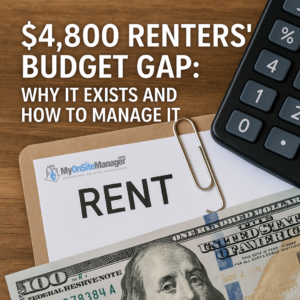In today’s fast-paced, competitive rental market, a monthly budget of $4,800 might sound like you’re shopping at the top of the market — but in reality, that figure doesn’t stretch as far as you might expect, especially in major metropolitan areas.
Rents have surged over the past few years, driven by inflation, limited housing supply, and post-pandemic shifts. Many renters are discovering that even with a robust budget, they’re still up against fierce competition, tight inventory, and surprisingly small spaces. So, what can $4,800 really get you, and how can renters make the most of it?
What $4,800 Means in Different Cities
Let’s break it down city by city:
-
New York City:
The Big Apple remains one of the priciest rental markets in the country. With $4,800, you’re often looking at a one-bedroom apartment in a trendy neighborhood like the West Village or Williamsburg — or perhaps a slightly larger space if you’re willing to venture to Upper Manhattan or the outer boroughs. Despite the hefty budget, renters often face bidding wars or have to settle for older buildings with fewer amenities. -
San Francisco:
Long known for sky-high rents, San Francisco gives you a one-bedroom apartment downtown or a two-bedroom further out in the Sunset or Richmond districts. Many newer units cater to the tech crowd, with luxury amenities baked into the price — but that also means you’re paying a premium for services you may not always use. -
Los Angeles:
LA offers a bit more breathing room for $4,800. In neighborhoods like Culver City or Silver Lake, you can secure a modern two-bedroom apartment or even a small rental house. But in ultra-desirable pockets like Santa Monica or Venice Beach, you’ll find that same budget is quickly absorbed by location premiums. -
Miami:
Miami’s real estate scene has boomed thanks to an influx of remote workers and luxury buyers. For $4,800, renters might get a sleek one- or two-bedroom unit in a new high-rise with beach views or amenities like pools and gyms. But competition is stiff, and rent increases have been among the fastest in the country. -
Other Cities (Boston, Seattle, Washington D.C.):
These high-cost cities mirror the challenges seen in New York and San Francisco — limited space, high demand, and expensive urban cores. In each, $4,800 offers comfort, but not necessarily luxury or space.
Why Doesn’t $4,800 Go as Far Anymore?
Several structural factors have changed the way the rental market operates at the high end:
-
Post-Pandemic Shifts: As people flocked back to cities post-lockdown, demand spiked, pushing rents up sharply, especially for larger or well-located units.
-
Luxury-Focused Development: Much of the new apartment construction over the last decade has targeted high-income renters, often with small units packed with luxury amenities, driving up base prices.
-
Additional Costs: Base rent is only part of the picture — parking fees, utilities, amenity charges, pet fees, and renters’ insurance can easily add several hundred dollars to the monthly bill.
-
Limited Inventory: With not enough middle-market or affordable units being built, even renters with bigger budgets end up competing for the same pool of units.
What Renters Can Do to Maximize Value
If you’re working with a $4,800 budget (or even less), there are several strategies to help stretch your housing dollars further:
Broaden Your Search Radius: Explore up-and-coming neighborhoods or nearby suburbs, where you may get significantly more space or better features for the same price.
Prioritize Must-Haves: Make a clear list of non-negotiables (e.g., commute time, square footage, pet-friendly policy) versus nice-to-haves (e.g., rooftop deck, concierge service).
Look for Concessions: In some markets, landlords offer perks like one or two months free rent, waived fees, or free parking. These can add up to major savings.
Be Ready to Act Fast: Desirable units go quickly. Have your documents (pay stubs, references, credit reports) ready so you can apply on the spot if needed.
Negotiate Where Possible: While base rent is often fixed, landlords may be flexible on things like move-in dates, pet fees, or lease length.
How the Broader Market Impacts Everyone
What’s happening at the $4,800 level highlights larger market dynamics affecting renters at all price points. Rising housing costs mean that even renters with strong incomes are feeling squeezed, which trickles down into tighter competition for mid-range and affordable units. Policymakers and housing advocates warn that without increased housing supply — especially affordable options — the market will continue to strain renters across the board.
Final Takeaway
A $4,800 monthly budget may open doors, but it doesn’t guarantee space, luxury, or choice in today’s overheated rental landscape. For renters navigating this market, it’s crucial to stay informed, flexible, and strategic to make the most of every dollar.
Want to explore the full details and data?
Check out the original article here: Finance Yahoo: Does a $4,800 Renter Budget Really Go That Far?

